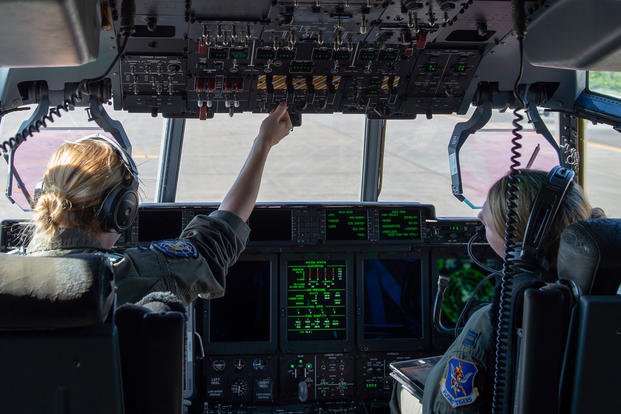Air Force pilots know what to expect when they're expecting: a whole lot of time on the ground.
But that could be changing, as the service undertakes a review to determine whether flight restrictions on pregnant pilots can be safely minimized or lifted. Lt. Col. Jammie Jamieson, the first female pilot to fly the Air Force's F-22 Raptor and a member of the Air Force Women's Initiative Team, said Wednesday that the service is looking to do away with any limits not justified by current science.
"We are actively conducting an ongoing policy review at this time, over the next quarter, to ensure that our aeromedical policy ... reflects current science, data and also balances operational risk management," she said at the quarterly meeting of the Defense Advisory Committee on Women in the Services, held near Washington, D.C.
"The overall goals of this review are to, wherever possible, remove pregnancy as disqualifying for flight ... improve retention rates along our aviation workforce for females and identify and document for all our aviators, male and female, the unknown occupational hazards to which they're exposed and eliminate potential barriers to aviator recruitment."
Related: Air Force Ditches Medical Waiver for Some Pregnant Airmen Who Want to Fly Longer
Earlier this year, the Air Force took the first steps toward eliminating excessive regulation on pregnant pilots, doing away with a medical waiver requirement for those who wanted to continue flying longer. It also expanded the standard window for flight duty, allowing pilots to fly from weeks 12 to 28 of gestation, where previously they had been limited to weeks 13 to 24. Officials emphasized, however, that no airmen would be forced to fly while pregnant.
Jamieson said the existence of the pregnancy restrictions serves as a deterrent to some would-be Air Force aviators.
"If our young women in pre-accession or accession programs essentially perceive that being a parent and being a pilot are incompatible occupations, they tend to not opt in at all," she said.
In the last year, she said, there were nearly 400 pregnant Air Force aviators "that were by policy prohibited from maintaining basic aviation qualifications."
At any given time, roughly 10% of female Air Force pilots are pregnant.
By contrast, commercial aviation under the Federal Aviation Administration cannot sideline female employees due to pregnancy.
Jamieson, a mother of three, discussed personal frustration earlier in her career when she found herself sidelined, as a pregnant instructor at the Air Force Academy, from flying the Cirrus SR-20, an aircraft with a parachute actually built into the frame as a safety mechanism. While the Air Force wouldn't let her fly it, she said, she could drive a few miles down the road to Meadow Lake Airport in Colorado and rent and fly the same plane "for as many hours as I wanted to."
"And so we're trying to update our policies to, you know, be able to compete with the civilian workforce, but also to be informed by what we know what we don't know," Jamieson said, "so we can inform the service and the members, and people can make informed choices."
-- Hope Hodge Seck can be reached at hope.seck@military.com. Follow her on Twitter at @HopeSeck.
Read more: Fired Air Force Academy Commandant Plans to File Complaint














